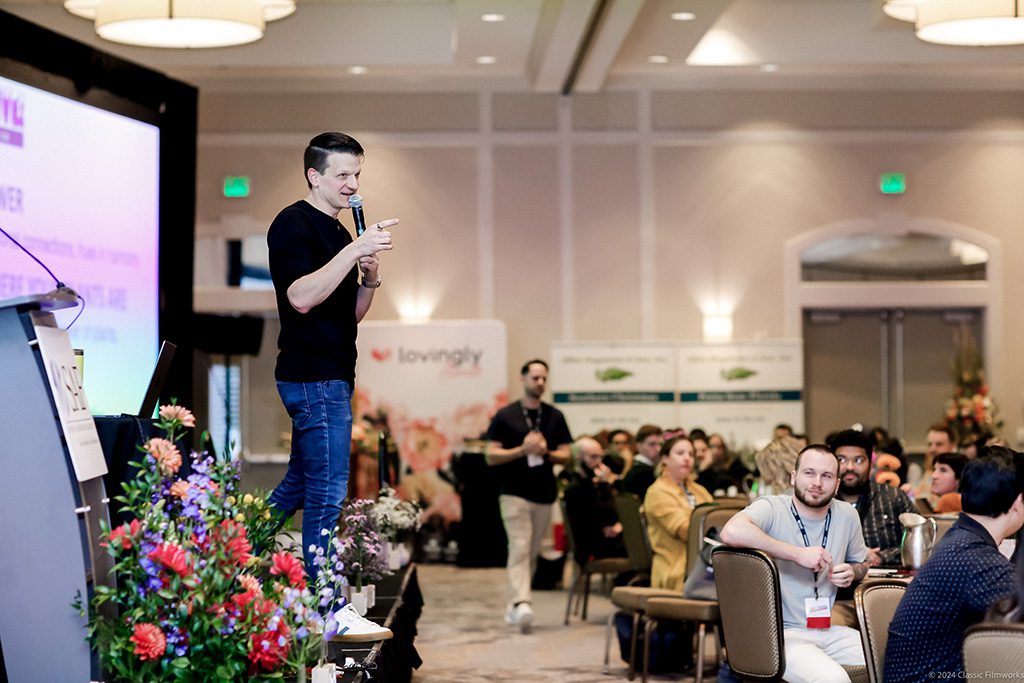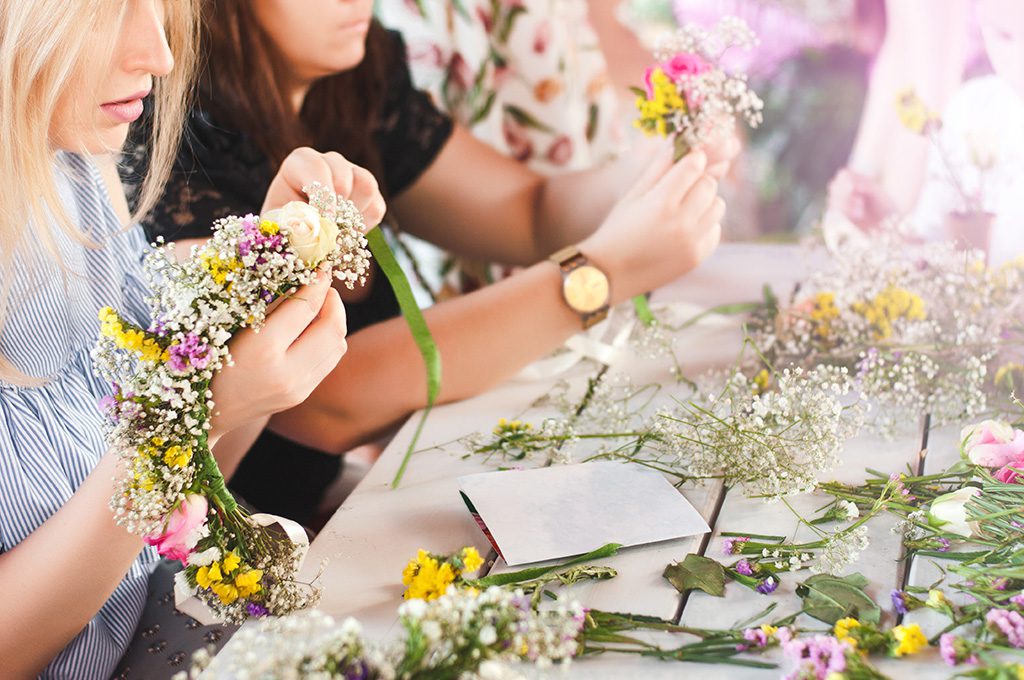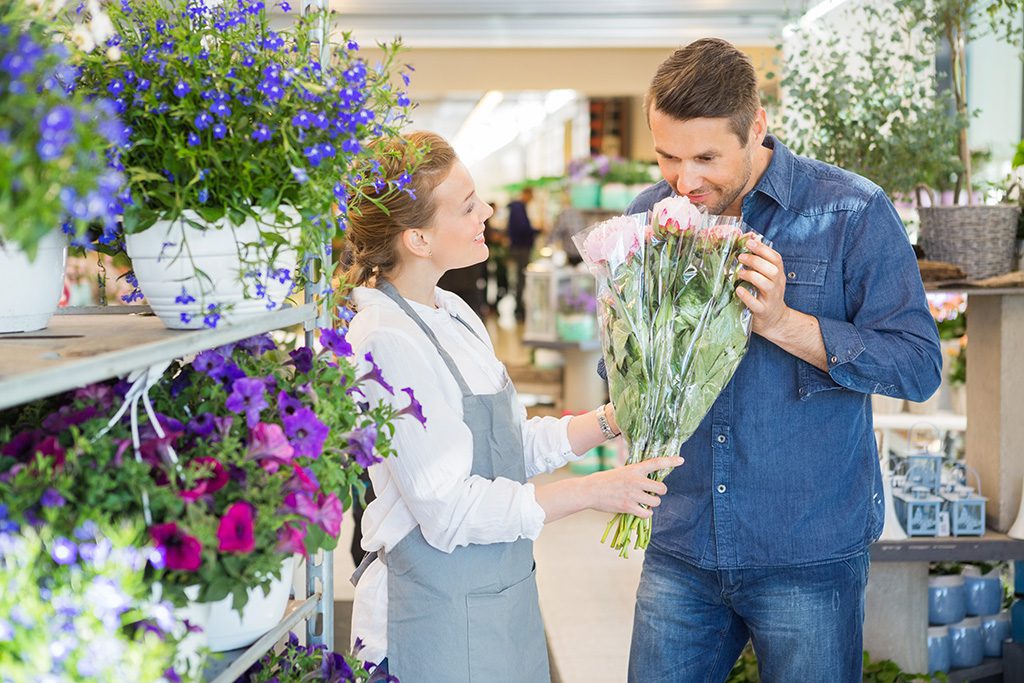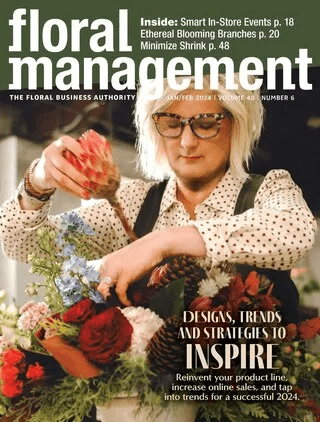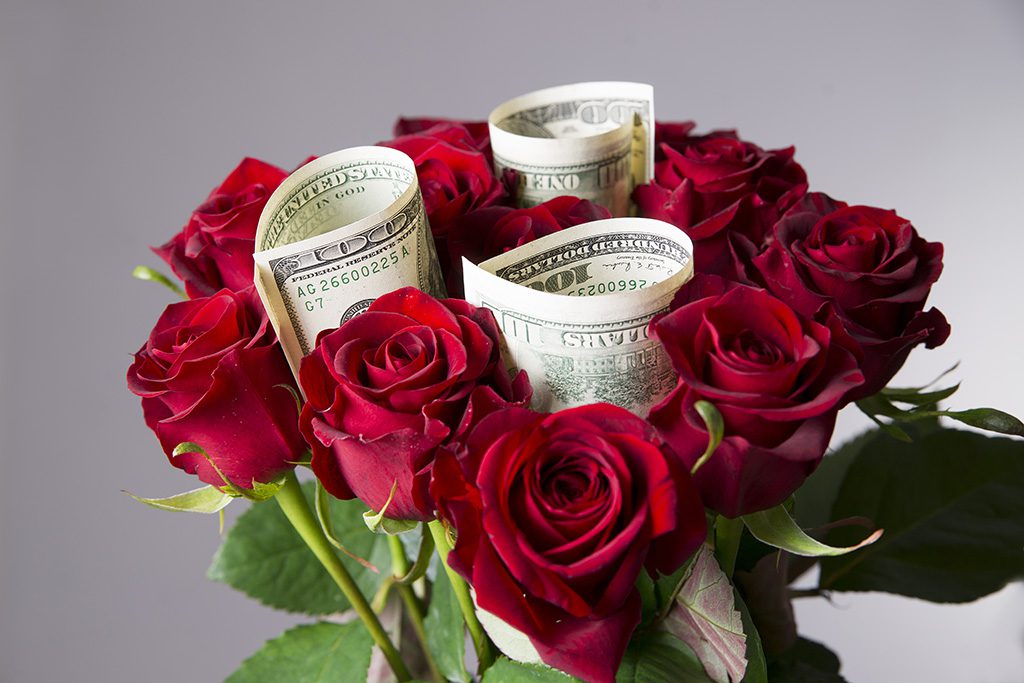
Valentine’s Day flower sales have shown slow but steady growth over the past two years, according to annual surveys by SAF and Ipsos.
Another Valentine’s Day is in the books, and with it, evidence of floral sales that for the past two years have showed slow but steady growth.
The findings of an Ipsos poll commissioned by the Society of American Florists about consumer spending, as well as SAF’s annual survey of retailers sales, indicate that, with few exceptions, Valentine’s Day sales were pretty similar to last year — which is good news.
The Ipsos poll found that the number of consumers who bought flowers and plants was slightly down from the record-breaking number in 2023, but still better than any other year since 2017.
And, sales, average order value and units sold were up this Valentine’s Day over last year for most florists who responded to the SAF annual survey about Valentine’s Day sales.
“It’s not stellar, but it is two years of consistent growth, and we are slowly moving in the right direction,” says SAF Chief Economist Charlie Hall, the Ellison Chair of Floriculture at Texas A&M University.
Consumer Spending
The results of this year’s Ipsos poll on consumer spending, which surveyed 1,005 adults from Feb. 15 to 16, show that 28% of Americans bought flowers and plants for Valentine’s Day, down from a record-breaking 34% last year, which was a 54% increase over the previous year. The poll has an error margin of 3.8 percentage points.

Source: Ipsos poll
Those results didn’t surprise Hall, who has been advising retailers to disregard the Conference Board’s consumer confidence index and the idea that consumers are tightening budgets.
“There is a disconnect about how we feel and how we spend,” he says. He points to data from the U.S. Department of Commerce and Wells Fargo Economics, which shows that discretionary spending is picking up after a slowdown in 2023. What are consumers spending on? Recreational goods and services — or in other words, experiences.
“People are doing things, creating experiences, creating memories, which should tell us something about the value proposition that we need to be putting forward,” Hall says.
Findings from the Ipsos poll reflect that spending trend. The average of amount of money consumers spent on flowers and plants fell from $58.40 in 2023 to $50.60 this year.
Who Bought for Whom?
The most common subgroups who purchased flowers for Valentine’s Day were similar to past years.

Source: Ipsos poll conducted Feb. 15-16, 2024
Seven in ten floral Valentine’s Day gifts were purchased for significant others, similar to last year. The poll found that 44% of recipients were spouses, while 26% were for significant others (down from 29% in 2023).
Flowers of Choice
Roses were the flower of choice, with 87% of flower purchasers choosing the flower, up from 85% in 2023 and gaining more popularity this year than previous years. Of those who bought roses, 67% purchased red roses, down from 74% in 2023. Pink and white roses were the next most popular choices. About 35% of respondents bought a bouquet of mixed flowers, about the same as in 2023.
Outlet of Choice
Once again, flower shops were the outlet of choice for one in four flower buyers. Home improvement stores also maintained their 9% share of customers. Grocery stores and mass marketers were the top outlet for fewer flower buyers this year compared to last: 26% for mass markets, down from 32%; and 38% for grocery stores, down from 43%. Independent garden centers, greenhouse and nursery saw a 16% decrease in customers, from 12% in 2023 to 10% in 2024.
The only category that saw more customers this year than last, according to the data, is internet floral services, with 15%, up from 13% in 2023.
Connecting Through Flowers Top of Mind
Asked about the top three factors that influence flower buying decisions in the next six months, connecting with friends and loved ones topped the list (56%, up from 47% in 2023). Affordability ranked second (40%, down from 48% in 2023), and convenience and ease of purchase ranked third (44%, similar to last year).
Sales, Order Value and Units Sold Up
More than half of florists (52%) who responded to SAF’s survey last month reported an increase in sales.

Source: SAF’s annual survey of retailers, conducted Feb. 19-March 1
Of those with increases, most (25%) reported an increase of between 1% and 5%. Websites saw the most growth in sales.

Source: SAF’s annual survey of retailers, conducted Feb. 19-March 1
Of those with losses, most saw 1% to 5% decreases in sales. Wire-in orders saw the biggest declines in sales.

Source: SAF’s annual survey of retailers, conducted Feb. 19-March 1
Average order values were up for 72% of respondents, indicating that florists have adjusted prices to adjust for rising costs, Hall says. Units sold also increased for nearly half of respondents.
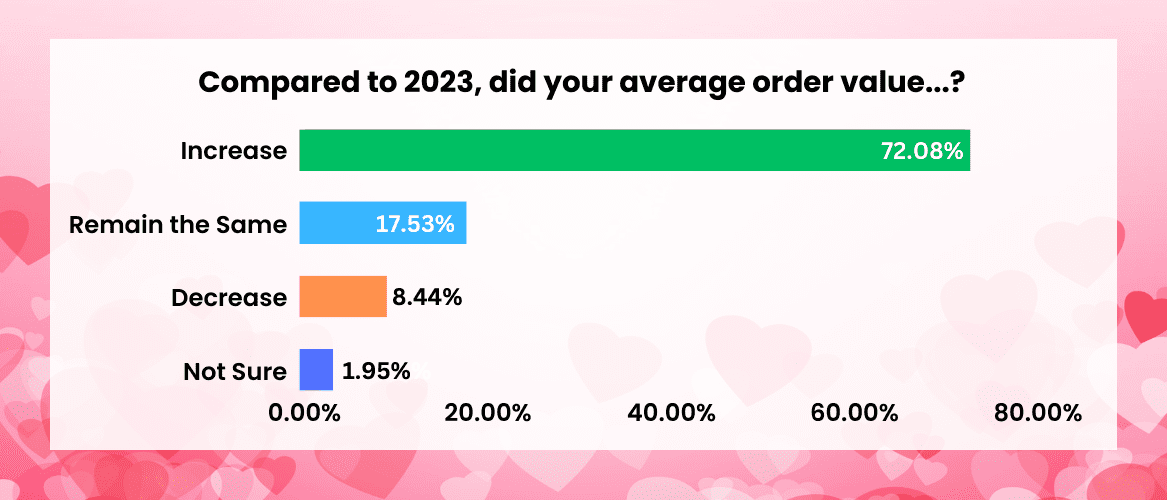
Source: SAF’s annual survey of retailers, conducted Feb. 19-March 1
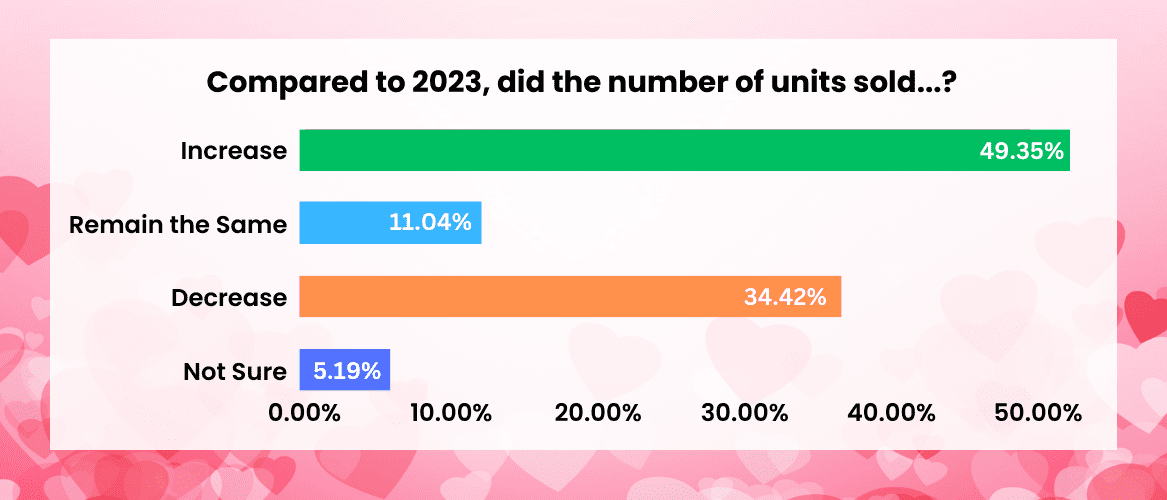
Source: SAF’s annual survey of retailers, conducted Feb. 19-March 1
“For me, this is the most optimistic part of the data — the fact that for half of them, their units increased,” Hall says.
Pre-Orders and Delivery
Florists went after pre-orders, and they got them. Thirty-six percent of respondents said between 26% and 50% of their orders came in before Valentine’s Day.

Delivery was another story, though. Florists were working around the clock to deliver flowers on the holiday, with just over half of respondents indicating they delivered more than 76% of orders on Valentine’s Day.
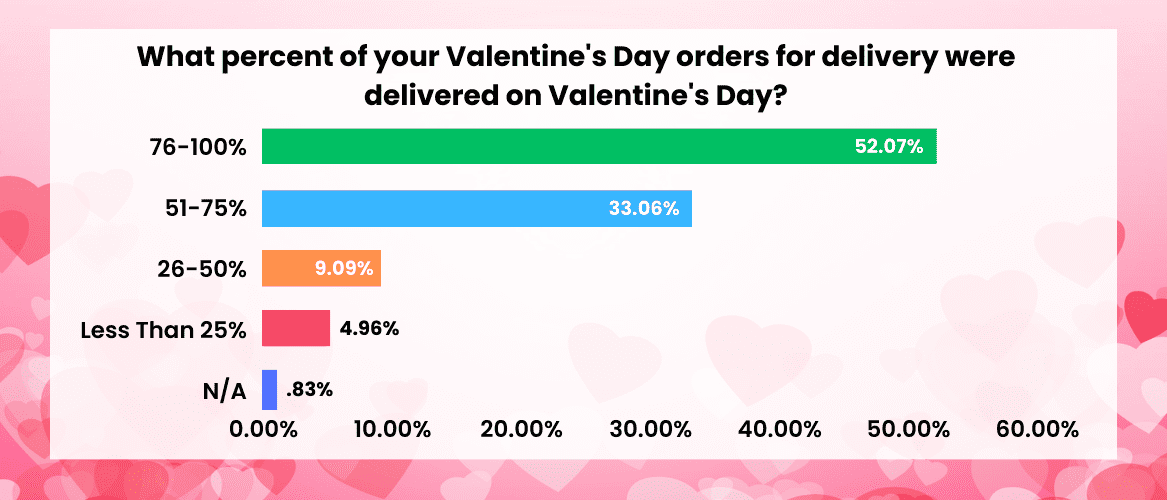
Source: SAF’s annual survey of retailers, conducted Feb. 19-March 1
About a third of respondents said they had to stop taking orders on Valentine’s Day, either because they didn’t have staff to fulfill them, or they ran out of product.
Challenges and Opportunities
The holiday wasn’t without challenges. Although many retailers agree a Wednesday holiday is beneficial because it doesn’t compete with weekend plans and gives them more time to prep, it was detrimental to retailers in areas where Mardi Gras (Feb. 13) and Ash Wednesday (Feb. 14) are celebrated. Retailers in the Northeast also had to contend with a winter storm that swept through the day before Valentine’s Day, bringing as much as 15 inches of snow to some areas.
“Having a snow day the day before was a detriment,” says Melanie Frassinelli of Bloom By Melanie in East Stroudsburg, Pennsylvania. If not for the storm, “deliveries and sales could have been a little less concentrated on one day.”
The timing of Valentine’s Day also presented opportunities.
“We had plenty of time to prepare arrangements in advance, so our coolers were nice and full,” says Charlotte Jacobs of McNamara Florist’s Ft. Wayne, Indiana location. “People were still celebrating Valentine’s Day through the [following] weekend, so we were still selling arrangements.”
Amanda Jedlinsky is the managing editor of SAF News Now.



